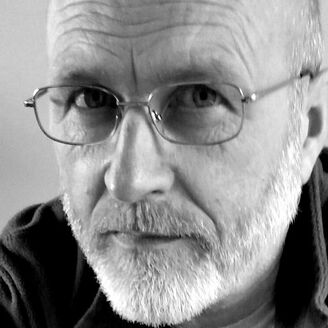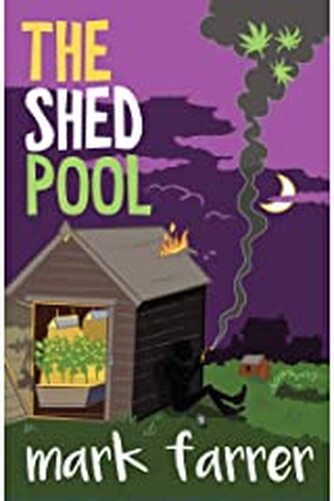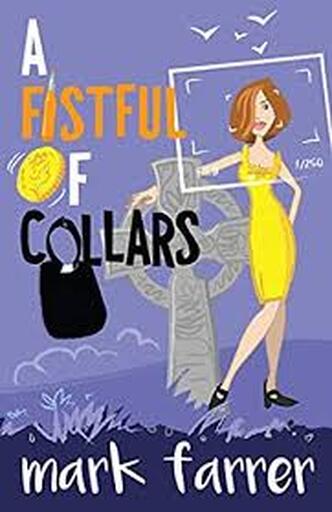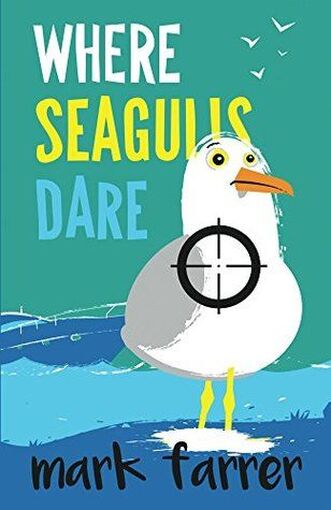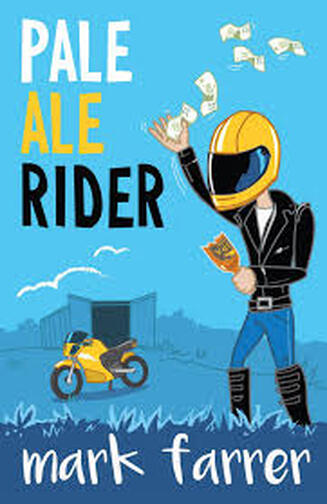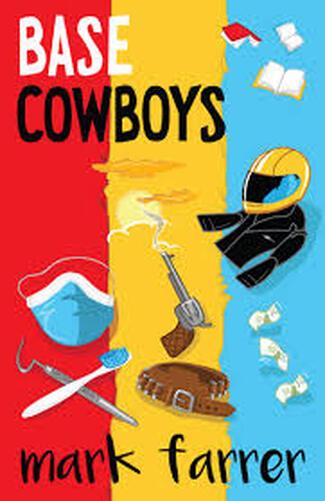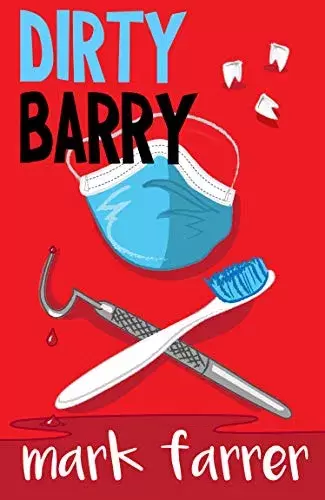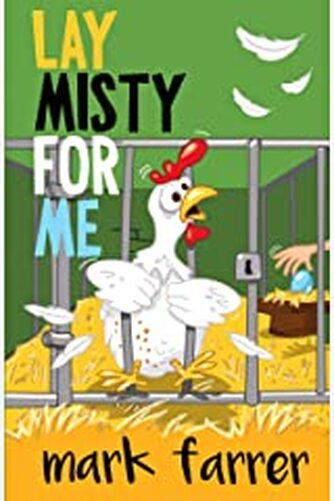
It gives me great pleasure to welcome Mark Farrer onto the website today. Mark is the author of eight comic novels in his Cullen & Big Paul series.
Alex: Mark, tell us a bit about yourself.
Mark: I’m an adopted Scot, originally from Liverpool. I lived and worked in London and the South-East for 20 years before moving up to Edinburgh in 2001. I retired from IT in 2015 and started writing full-time. I have three grown-up children, two currently at University and one who graduated from Dundee last year with a First!
My latest novel, Lay Misty For Me is the eighth book in my CULLEN & BIG PAUL series, although all of the books are standalone stories and can be read in any order.
Alex: How would you describe your writing, and are there particular themes that you like to explore?
Mark: My books are comedies which revolve around a bad guy who gets his comeuppance in a fitting way, courtesy of Cullen & Big Paul. They have been compared to writers like Caimh McDonnell, Chris Brookmyre, Tom Sharpe and Carl Hiaasen. In each book there is a different immoral baddie who is committing some crime which offends Cullen’s very individual sense of right and wrong.
All of my books are set in Scotland with strong Scottish themes and backdrops. So far, I have touched on salmon farming, Scottish football, the Church of Scotland, textile mills, the Scottish Courts System and the Melrose Rugby Sevens tournament. I have a spreadsheet (I’m big on spreadsheets!) full of many more: whisky, North Sea Oil, Hogmanay, the Forth Bridges, sheep-farming, bio-sciences, wave & wind energy, Edinburgh Festival, ship-building, etc.
Alex: Mark, tell us a bit about yourself.
Mark: I’m an adopted Scot, originally from Liverpool. I lived and worked in London and the South-East for 20 years before moving up to Edinburgh in 2001. I retired from IT in 2015 and started writing full-time. I have three grown-up children, two currently at University and one who graduated from Dundee last year with a First!
My latest novel, Lay Misty For Me is the eighth book in my CULLEN & BIG PAUL series, although all of the books are standalone stories and can be read in any order.
Alex: How would you describe your writing, and are there particular themes that you like to explore?
Mark: My books are comedies which revolve around a bad guy who gets his comeuppance in a fitting way, courtesy of Cullen & Big Paul. They have been compared to writers like Caimh McDonnell, Chris Brookmyre, Tom Sharpe and Carl Hiaasen. In each book there is a different immoral baddie who is committing some crime which offends Cullen’s very individual sense of right and wrong.
All of my books are set in Scotland with strong Scottish themes and backdrops. So far, I have touched on salmon farming, Scottish football, the Church of Scotland, textile mills, the Scottish Courts System and the Melrose Rugby Sevens tournament. I have a spreadsheet (I’m big on spreadsheets!) full of many more: whisky, North Sea Oil, Hogmanay, the Forth Bridges, sheep-farming, bio-sciences, wave & wind energy, Edinburgh Festival, ship-building, etc.
Alex: Are you a writer that plans a detailed synopsis or do you set out with a vague idea and let the story unfold as you write?
Mark: I’m very much a plotter, not a pantster. I start with the title - all my titles are puns on Clint Eastwood films, so the pun gives me a connection to a theme or setting. I have an over-arching storyline for Cullen & Big Paul I need to weave in, plus I need a nasty villain who gets his comeuppance for a particular crime in some becoming fashion and then colourful local characters who each have their own motivations. It’s a bit like constructing a jigsaw puzzle – taking all these pieces and trying to make them align within a plot that has a beginning, middle and end! This usually takes about 4 weeks for a novel.
I produce a flowchart for the story where each box on the chart is a scene in the book. When I have around 100 scenes I feel I have a novel-length story. Then I work on the first draft: I write 10,000 words a week and usually write long which means my first draft will be 120,000+ words, so this takes 3-4 months.
I then do the rewrite which is the hardest part. This involves cutting away a lot of the dead wood and trying to make the story make sense (as I have usually discovered during the first draft that my flowchart had errors or omissions which “break” the story). I delete characters and scenes, write new ones and tweak a lot to make things consistent. This takes about 6 weeks, but often longer as I get overwhelmed at how much needs to be done so usually put this stage off for weeks and weeks!
By then I have my 'alpha' copy which I am prepared to let my partner read and critique. Based on her feedback I may make some structural changes and, while she is reading it, I will go through it again myself, reading it aloud, to find typos, inconsistencies, repetition and that sort of thing. Once I have made all of these changes – say, another 3-4 weeks – I send it to my Beta readers and ask for their comments. I allow a further 3-4 weeks for their feedback and any changes I then make. While all this is going on, I get my cover design done and then the book is ready to be published!
Alex: Tell us about your latest novel.
Mark: Lay Misty For Me is a comedy about an unscrupulous egg farmer who gets his comeuppance for stopping at nothing to secure a lucrative supermarket contract, including flouting animal welfare rules and evicting tenant farmers to make space for more chicken sheds. It was released in December 2020.
I am now plotting my next two books – a novella, Trouble With The Perv, due out in Spring 2021, and another novel, Two Fuels For Sister Sarah, towards the end of 2021.
All my books are published by my own imprint, Funny Business Press, and available only on Amazon. The novels are £3.99 (Kindle) and £10.99 (paperback); the novellas are £1.99 (Kindle) and £4.99 (Paperback).
Alex: What was the first book you read?
Mark: I don’t remember that far back! I guess it was a Janet & John book at school. I do know I was a voracious reader as a child and used to go with my Dad to the library every week and take out 4 or 5 books at a time.
Alex: How much research do you do and what does it usually entail?
Mark: I tend to do a lot of research for my books. For my first book, Where Seagulls Dare, I didn’t need to do much at all as I had worked in the salmon farming industry, visited many sites and understood a lot about the business before I started. This wasn’t the case for my other books, as I later realised. I am constantly impressed and delighted by the willingness of the people I approach asking for information about their job, business or specialist expertise, especially since they don’t know me and will gain no benefit from me using their knowledge or situation in a book. I also tend to ask off-kilter questions – as per the plots of my books – which get me funny looks a lot. For example, asking the Melrose Rugby Club president if his trophy cabinet was alarmed and what would happen if someone broke in to steal a trophy, or asking the tour guide at a Nuclear Power Station if it would be possible for someone to smuggle out some enriched uranium, or asking the owner of a textile mill if interfering with any of the machinery could cause severe injuries!
For A Fistful Of Collars, I visited textile mills in Elgin and Hawick, googled madly about London Fashion Week and the Church of Scotland. I also went to watch a Hibs game at Easter Road so that I could establish which tenement window a hitman would have to use in order to shoot someone in the stands. I wasn’t interested in the match at all!
Mark: I’m very much a plotter, not a pantster. I start with the title - all my titles are puns on Clint Eastwood films, so the pun gives me a connection to a theme or setting. I have an over-arching storyline for Cullen & Big Paul I need to weave in, plus I need a nasty villain who gets his comeuppance for a particular crime in some becoming fashion and then colourful local characters who each have their own motivations. It’s a bit like constructing a jigsaw puzzle – taking all these pieces and trying to make them align within a plot that has a beginning, middle and end! This usually takes about 4 weeks for a novel.
I produce a flowchart for the story where each box on the chart is a scene in the book. When I have around 100 scenes I feel I have a novel-length story. Then I work on the first draft: I write 10,000 words a week and usually write long which means my first draft will be 120,000+ words, so this takes 3-4 months.
I then do the rewrite which is the hardest part. This involves cutting away a lot of the dead wood and trying to make the story make sense (as I have usually discovered during the first draft that my flowchart had errors or omissions which “break” the story). I delete characters and scenes, write new ones and tweak a lot to make things consistent. This takes about 6 weeks, but often longer as I get overwhelmed at how much needs to be done so usually put this stage off for weeks and weeks!
By then I have my 'alpha' copy which I am prepared to let my partner read and critique. Based on her feedback I may make some structural changes and, while she is reading it, I will go through it again myself, reading it aloud, to find typos, inconsistencies, repetition and that sort of thing. Once I have made all of these changes – say, another 3-4 weeks – I send it to my Beta readers and ask for their comments. I allow a further 3-4 weeks for their feedback and any changes I then make. While all this is going on, I get my cover design done and then the book is ready to be published!
Alex: Tell us about your latest novel.
Mark: Lay Misty For Me is a comedy about an unscrupulous egg farmer who gets his comeuppance for stopping at nothing to secure a lucrative supermarket contract, including flouting animal welfare rules and evicting tenant farmers to make space for more chicken sheds. It was released in December 2020.
I am now plotting my next two books – a novella, Trouble With The Perv, due out in Spring 2021, and another novel, Two Fuels For Sister Sarah, towards the end of 2021.
All my books are published by my own imprint, Funny Business Press, and available only on Amazon. The novels are £3.99 (Kindle) and £10.99 (paperback); the novellas are £1.99 (Kindle) and £4.99 (Paperback).
Alex: What was the first book you read?
Mark: I don’t remember that far back! I guess it was a Janet & John book at school. I do know I was a voracious reader as a child and used to go with my Dad to the library every week and take out 4 or 5 books at a time.
Alex: How much research do you do and what does it usually entail?
Mark: I tend to do a lot of research for my books. For my first book, Where Seagulls Dare, I didn’t need to do much at all as I had worked in the salmon farming industry, visited many sites and understood a lot about the business before I started. This wasn’t the case for my other books, as I later realised. I am constantly impressed and delighted by the willingness of the people I approach asking for information about their job, business or specialist expertise, especially since they don’t know me and will gain no benefit from me using their knowledge or situation in a book. I also tend to ask off-kilter questions – as per the plots of my books – which get me funny looks a lot. For example, asking the Melrose Rugby Club president if his trophy cabinet was alarmed and what would happen if someone broke in to steal a trophy, or asking the tour guide at a Nuclear Power Station if it would be possible for someone to smuggle out some enriched uranium, or asking the owner of a textile mill if interfering with any of the machinery could cause severe injuries!
For A Fistful Of Collars, I visited textile mills in Elgin and Hawick, googled madly about London Fashion Week and the Church of Scotland. I also went to watch a Hibs game at Easter Road so that I could establish which tenement window a hitman would have to use in order to shoot someone in the stands. I wasn’t interested in the match at all!
|
For The Good, The Bad & The Rugby I was given a guided tour of The Greenyards rugby ground by the Club President, and had tea with a group of club veterans. I attended Sevens tournaments at Melrose, Peebles and Galashiels, climbed the Eildon Hills and photographed an abandoned house near Selkirk which also plays a role in the story. I even arranged to go to a Sheriff Court to watch the jury selection process! For Lay Misty For Me, I visited an egg farm in East Lothian (nothing like the one I write about, I should point out!) and got to ask questions like “Could your hens actually kill a man?”.
For Bronchial Billy I visited the Grand Ole Opry in Glasgow and spoke to some of the gunslingers there. And for Pale Ale Rider, I had a tour of Broughton Ales Brewery from one of the company Directors – and got some free bottles of beer into the bargain. Who said research can’t be fun! Alex: Do you ever base your characters on people you have encountered in real life? Mark: Absolutely. I have taken names and characteristics from several people and used them in some of my books – some barely disguised at all! Sometimes I just use a person’s name, or a distortion of it, other times I steal catchphrase or rhythms of speech or some other central mannerism for a character. However, it seems to me that most of my characters are based on one aspect of myself which I then exaggerate and distort – so there’s an angry me, a bitter me, a sarcastic me, a selfish me, a sentimental me, a paranoid me, and so on. And I also make a point of giving every character some incident in their backstory which is from my own past, whether big or small, for colour. Alex: Which was the last book you read that blew you away? Mark: I have to say that, since I started writing, I have had tremendous difficulty reading fiction. I can’t seem to immerse myself in a book now without studying the writing, spotting foreshadowings early, picking up on clumsy writing, and so on. I spend all my time thinking either “Oh, that’s neat. I should do something like that in my next book!” or “Hmm. That’s a bit poor. I’m going to stop reading now.” So, I suppose the last book that blew me away was the book which finally pushed me into writing in the first place. This was a book by Tim Dorsey called Triggerfish Twist. It is black, bitingly funny, sharp and just brilliant. It was the fourth book in a series (which I hadn’t realised when I bought it) so I went back and started his Book One – but found that one awful and I couldn’t finish it! So I tried Book Two, which was slightly better but still not a patch on Book Four, and I thought: “I may never be able to write a book as good as his Book Four but I bet I could write a better book than his first one! And if I did, and I wrote more, maybe by the time I had written five or six I’d have a good one!” So I started writing. Alex: How do you market your books? Mark: I have tried all sorts over the years – and am still learning. I have done all the things which Indie Authors are “supposed to do”: have a website, a social media presence, advertise on Facebook and Amazon, use discounting or giveaways services, build a mailing list from a regular newsletter, the list is endless. Currently I focus on:
I also don’t do much with offline, real-world channels (like book stores, etc) as they just don’t scale so I tend not to do book launches, business cards, flyers etc. I did do several hundred flyers for my book based around the Melrose Sevens and spent the whole day sticking them under the windscreen wipers of parked cars and handing them to passers-by, inside and outside the ground, on match day. I think I got one sale as a result. I also got thrown out of the Edinburgh Book Festival village for trying to hand out flyers to people waiting in line to see Doddie Weir! Alex: What are your interests aside from writing? And what do you do to unwind? Mark: When I am not writing I like noodling on my piano or guitar, hill-walking, cooking and playing board games. I currently live in Midlothian, just outside Edinburgh, so can nip up the Pentlands whenever I want to. I am also getting back into photography and taking my camera with me whenever I go for a walk to see if I can capture one good photo per walk. Alex: Which authors do you particularly admire and why? Mark: The authors who I most admire are those from whom I have learnt, and taken, so much: Carl Hiaasen (who sort of created the crime-comedy genre I write in and whose novels also inspired my main recurring character Cullen); Charles Dickens (for his creation of brilliant grotesques characters and his descriptive passages – totally inspiring); Stephen King (for his ability to create immersive and rich characters seemingly at will – but not, alas, for his plotting or endings which are nearly always a letdown – and for his advice on writing); PG Wodehouse (for his wit, lightness of touch, sheer Britishness and mastery of understatement); and Ed McBain (for his 57th Precinct novels which show how compelling stories can work with an ensemble cast rather than a single hero, and for his consistency of structure - I would recommend anyone thinking of writing books to try and reverse engineer his books which are amazing in their regularity and structure). All of these writers are/were also tremendously disciplined and prolific -churning out many books each. My top tip for any aspiring or new writer is (as Stephen King says): write. Then keep writing. It is a tremendously competitive market and there are thousands and thousands of people who reckon they can write – one “easy” way to stand out is to persist. If a reader sees a single book by an author they’ve never heard of, they can easily dismiss it as some fly-by-night author – but if they see a body of work from a writer who has stuck at it, they are more likely to think this is a writer whose books are worth a look. Alex: Thank you so much Mark for your thoughtful and fullsome answers. It's been fascinating to hear how you work. Mark: And thank you for having me, Alex. |
